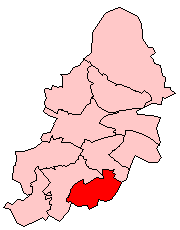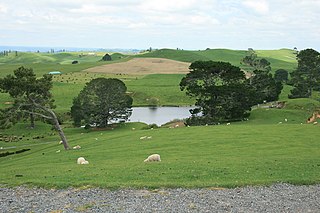
Hobbits or Halflings are a fictional human-like race in the novels of J. R. R. Tolkien, about half the height of humans. They live barefooted, and live in underground houses which have windows, as they are typically built into the sides of hills.

Bilbo Baggins is the title character and protagonist of J. R. R. Tolkien's 1937 novel The Hobbit, a supporting character in The Lord of the Rings, and the fictional narrator of all Tolkien's Middle-earth writings. The Hobbit is selected by the wizard Gandalf to help Thorin and his party of Dwarves to reclaim their ancestral home and treasure, which has been taken over by the dragon Smaug. Bilbo sets out in The Hobbit timid and comfort-loving, and through his adventures grows to become a useful and resourceful member of the quest.

Moseley is a suburb of south Birmingham, England, 3 miles south of the city centre. The area is a popular cosmopolitan residential location and leisure destination, with a number of bars and restaurants. The area also has a number of boutiques and other independent retailers.

The River Cole is a 25 miles (40 km) river in the English Midlands. It rises on the lower slopes of Forhill, one of the south-western ramparts of the Birmingham Plateau, at Red Hill and flows south before flowing largely north-east across the plateau to enter the River Blythe below Coleshill, near Ladywalk, shortly before the Blythe meets the Tame. This then joins the Trent, whose waters reach the North Sea via the Humber Estuary. Its source is very near the main watershed of Midland England : tributaries are few and very short except in the lower reaches, so the Cole is only a small stream.
"The Scouring of the Shire" is the penultimate chapter of the heroic romance The Lord of the Rings by J. R. R. Tolkien. The Fellowship hobbits, Frodo, Sam, Merry, and Pippin, return home to the Shire to find that it is under the brutal control of ruffians and their leader "Sharkey", revealed to be the Wizard Saruman. The ruffians have despoiled the Shire, cutting down trees and destroying old houses, as well as replacing the old mill with a larger one full of machinery which pollutes the air and the water. The hobbits rouse the Shire to rebellion, lead their fellow-hobbits to victory in the Battle of Bywater, and end Saruman's rule.

Hall Green is an area in southeast Birmingham, England. It is also a council constituency, managed by its own district committee. Historically it lay within the county of Worcestershire.

Sarehole is an area in Hall Green, Birmingham, England. Historically in Worcestershire, it was a small hamlet in the larger parish, and manor, of Yardley, which was transferred to Birmingham in 1911. Birmingham was classed as part of Warwickshire until 1974, and since then has been part of the West Midlands.

Stechford is an area of East Birmingham, England, situated about five miles east of the city centre, bordering Ward End, Yardley, Hodge Hill and Kitts Green. Historically it lay within Worcestershire.
Stirchley is in the south west of Birmingham, England.

Moseley Bog, formerly The Dell, is a Local Nature Reserve in the Moseley area of Birmingham, England.

Sarehole Mill is a Grade II listed water mill, in an area once called Sarehole, on the River Cole in Hall Green, Birmingham, England. It is now run as a museum by the Birmingham Museums Trust. It is known for its association with J. R. R. Tolkien and is one of only two working water mills in Birmingham, with the other being New Hall Mill in Walmley, Sutton Coldfield.

New Hall Valley Country Park is a country park located in New Hall Valley between Walmley, Wylde Green and Pype Hayes in the Sutton Coldfield area of north Birmingham. It is the first new country park in the UK for over a decade. The park is split into "phases".
John Morris Jones Walkway is a path on the River Cole in Hall Green, Birmingham, England. It is part of the Shire Country Park.

Wake Green is a historical area in south Birmingham, England between Moseley, Kings Heath, and Hall Green.
Greet is a historical area in south Birmingham, England, around modern Sparkhill.

The Shire is a region of J. R. R. Tolkien's fictional Middle-earth, described in The Lord of the Rings and other works. The Shire is an inland area settled exclusively by hobbits, the Shire-folk, largely sheltered from the goings-on in the rest of Middle-earth. It is in the northwest of the continent, in the region of Eriador and the Kingdom of Arnor.
The Tolkien Society is an educational charity and literary society devoted to the study and promotion of the life and works of the author and academic J. R. R. Tolkien.

The theme of environmentalism in The Lord of the Rings has been remarked by critics since the 1970s. The Hobbits' visions of Saruman's industrial hell of Isengard and Sauron's desolate polluted land of Mordor have been interpreted as comments on modern society, while the destruction of Isengard by the tree-giant Ents, and "The Scouring of the Shire" by the Hobbits, have a strong theme of restoration of the natural environment after such industrial pollution and degradation. However, Tolkien's love of trees and unspoilt nature is apparent throughout the novel.














